By Jeffrey A. Rendall; Photos by Jeff and Shari Rendall
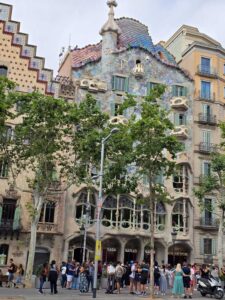 BARCELONA, SPAIN — To begin with, I admit when we booked a cruise tour of Italy and Spain that I was somewhat less enthused about… the Spanish destinations on the itinerary. Don’t get me wrong, I certainly was interested in visiting and learning about Barcelona, our third stop on the relatively quick jaunt around the Mediterranean, but I knew somewhat less about what we’d find there compared with the “headlining” ports of Rome and Naples (site of Pompeii, etc.) and Florence.
BARCELONA, SPAIN — To begin with, I admit when we booked a cruise tour of Italy and Spain that I was somewhat less enthused about… the Spanish destinations on the itinerary. Don’t get me wrong, I certainly was interested in visiting and learning about Barcelona, our third stop on the relatively quick jaunt around the Mediterranean, but I knew somewhat less about what we’d find there compared with the “headlining” ports of Rome and Naples (site of Pompeii, etc.) and Florence.
My previous exposure to Barcelona stemmed from viewing coverage of the 1992 Olympics on TV, specifically recalling how vividly the presenters of the games described the beauty and friendliness of the locale. It left a positive impression so as to desire a future visit there, which hadn’t occurred until first setting foot on Spanish soil during our cruise. My daughter had preceded us in this regard, visiting Barcelona ten years ago. When asked to describe Spain’s second largest city, she replied that its architecture was distinctive and memorable (more on this below), and that Barcelona was a “fun” city with entire streets dedicated to people congregating and “hanging out.”
My kid’s description of the metropolis was mostly accurate, as Barcelona seemed like a very large and welcoming place with residents who were visibly similar in manners and customs to those of today’s Rome and Naples. Spaniards weren’t the least bit put off by the hordes of visitors who make the city feel densely packed, and, for a lack of a better way to describe it, crowded in places.
 Situated on the northern coast of the Mediterranean in eastern Spain, Barcelona features a rich history, but the evidence of the city’s ancient past is not quite as pervasive and enveloping as was Rome’s.
Situated on the northern coast of the Mediterranean in eastern Spain, Barcelona features a rich history, but the evidence of the city’s ancient past is not quite as pervasive and enveloping as was Rome’s.
Not exactly overshadowed, Barcelona, from Wikipedia, “Founded as a Roman city, in the Middle Ages Barcelona became the capital of the County of Barcelona. After joining with the Kingdom of Aragon to form the confederation of the Crown of Aragon, Barcelona, which continued to be the capital of the Principality of Catalonia, became the most important city in the Crown of Aragon and the main economic and administrative centre of the Crown, only to be overtaken by Valencia, wrested from Moorish control by the Catalans, shortly before the dynastic union between the Crown of Castile and the Crown of Aragon in 1492. Barcelona became the centre of Catalan separatism, briefly becoming part of France during the 17th century Reapers’ War and again in 1812 until 1814 under Napoleon…
“Barcelona has a rich cultural heritage and is today an important cultural centre and a major tourist destination. Particularly renowned are the architectural works of Antoni Gaudí and Lluís Domènech i Montaner, which have been designated UNESCO World Heritage Sites. The city is home to two of the most prestigious universities in Spain: the University of Barcelona and Pompeu Fabra University. The headquarters of the Union for the Mediterranean are located in Barcelona. The city is known for hosting the 1992 Summer Olympics as well as world-class conferences and expositions. In addition, many international sport tournaments have been played here.”
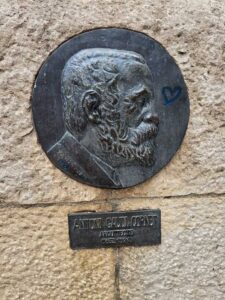
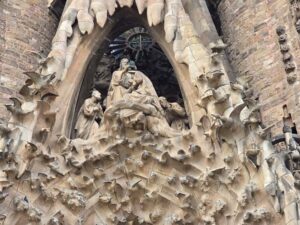 So, Barcelona more or less dates to the times of Rome’s founding, but, as previously mentioned, the outward signs of ancient human activity aren’t nearly as ubiquitous there. The architectural work of Antoni Gaudí particularly caught our attention seeing as the city’s main tourist attraction – and signature site – is the incredible Sagrada Família, the world’s largest unfinished church. The cathedral mimics some of the attributes of Italian churches and, at least in size, is comparable to the unbelievable St. Peter’s Basilica at the Vatican.
So, Barcelona more or less dates to the times of Rome’s founding, but, as previously mentioned, the outward signs of ancient human activity aren’t nearly as ubiquitous there. The architectural work of Antoni Gaudí particularly caught our attention seeing as the city’s main tourist attraction – and signature site – is the incredible Sagrada Família, the world’s largest unfinished church. The cathedral mimics some of the attributes of Italian churches and, at least in size, is comparable to the unbelievable St. Peter’s Basilica at the Vatican.
Barcelona is more modern than were the Italian cities we visited (Rome and Naples), which lent itself to more easily finding our way around as well as appreciating the wider avenues and visitor-friendly areas for concentrations of gobs of tourists and diners, shoppers and good time-seekers.
I was impressed by the sheer size of Barcelona, which, with its suburbs gave it much more of a sprawling feel than the others. To me, having grown up in southern California in the Los Angeles metro area, which goes on for dozens and dozens of miles, it made Barcelona feel much more like an American-type city. The cleanliness of the city center (which is pretty much all we saw) contrasted greatly with today’s American blue city downtowns, however, which are overrun with crime, illegal immigration and homelessness to the point where the non-official residents of these places have completely taken over.
I have a friend who relayed details on a recent visit to Los Angeles, for example, who described fearing for his safety by merely exiting his hotel for a short walk down the street to get coffee at Starbucks. There was no such apprehension in Barcelona for us, and the large and visible police presence lent itself the impression that one could walk around freely without worry of being accosted by scruffy homeless inhabitants.
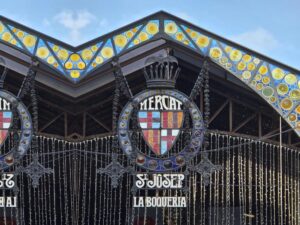 As a side note, we made our own morning jaunt to Starbucks and the streets were relatively deserted at that hour on a Sunday. Many shops and businesses were closed on Sunday, as we quickly learned.
As a side note, we made our own morning jaunt to Starbucks and the streets were relatively deserted at that hour on a Sunday. Many shops and businesses were closed on Sunday, as we quickly learned.
As everyone knows, the current American president has spent a lot of hours in placed such as New York City throughout his life, where he always takes the opportunity to thank New York’s finest whenever he visits. In last year’s campaign, Trump emphasized how he intended to restore order to America’s cities if elected for a second term, a vow kept this year.
I also presume Trump’s traveled to Barcelona and visited some of the places we did on our brief one-day tour, and I’m sure he must’ve been impressed with the pride the local authorities exhibited through their well-run (by appearances) city. Part of Trump’s Make America Great Again platform included making the country beautiful again – which couldn’t take place without a major infusion of cash to clean up the locales, and by returning to an old-fashioned emphasis on law enforcement.
Again, this is conjecture based on what I observed, but the Spanish leaders don’t appear to be plagued by illegal immigration as America certainly is – or was, before Trump came onboard – and many of Old Europe’s countries as well, primarily aliens from northern Africa and the Middle East. Spain’s culture appears to be tighter and more unified than ours would be with half of the American political spectrum not only advocating an influx of uninvited aliens – but paving the way for them in the U.S.
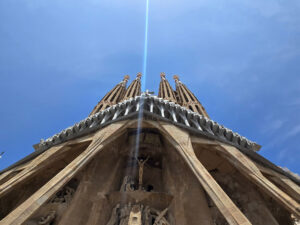 It’s also common knowledge that there have been terrorist attacks in Europe in our lifetimes, a fact that doesn’t seem lost on the Spanish authorities. The immensely crowded squares and touristy avenues didn’t carry a feeling of impending danger, however, but with the world the way it is today, it’s best to be cautious.
It’s also common knowledge that there have been terrorist attacks in Europe in our lifetimes, a fact that doesn’t seem lost on the Spanish authorities. The immensely crowded squares and touristy avenues didn’t carry a feeling of impending danger, however, but with the world the way it is today, it’s best to be cautious.
Like in Rome, there are lessons for America’s political leaders found in the streets and stunningly modern architecture of Barcelona. First, there still is a place for religion in America. Most visitors to European cities realize that inhabitants of the continent are much less religiously observant than they were in previous eras, but it’s unmistakable that Europe’s most enduring art and architecture revolves around the Bible and Christianity.
It’s not clear that the Spaniards still take pride in their faith as they did in the past, but faith cannot easily be tucked away and forgotten like it is in parts of secular America. American political leaders gain nothing by deemphasizing the importance of concepts like religious freedom, freedom of worship, freedom of conscience and, more attenuated, prayer in schools.
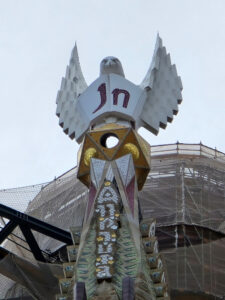 I can’t say for sure, but here’s guessing most of the visitors to the Sagrada Família went there knowing the site still functions as a church and the iconography and art fixtures make no attempt to hide that fact. As previously mentioned, the church itself is unfinished, and its keepers intend to complete Antoni Gaudí’s plan to the letter.
I can’t say for sure, but here’s guessing most of the visitors to the Sagrada Família went there knowing the site still functions as a church and the iconography and art fixtures make no attempt to hide that fact. As previously mentioned, the church itself is unfinished, and its keepers intend to complete Antoni Gaudí’s plan to the letter.
There’s history in Barcelona as well as religion. I’d have a hard time envisioning the Spanish culture tolerating bands of miscreants protesting and causing physical damage to Barcelona’s most sacred sites, including an extremely prominent statue of Christopher Columbus. Spaniards, unlike today’s American leftists, take pride in their culture and history.
To the extent Trump is able to influence such things during his second term, the 47th president must dig deep into using the bully pulpit to fight back against the leftist forces of ignorance and destruction.
Similar to Rome, the citizens of Barcelona also revere scientific learning and excellence. Antoni Gaudí may have dreamed up his architecture, but there were craftsman and construction personnel who made the visions into reality.
As Trump has often done, he’s highlighted the skill and accomplishments of people who work with their hands – and he’s been rewarded with their loyalty. In contrast, senile Joe Biden often mentioned that he’s a friend to the union heads and public employee conglomerations, but he did so by promising more federal government protections for the political class, not the men and women doing the work.

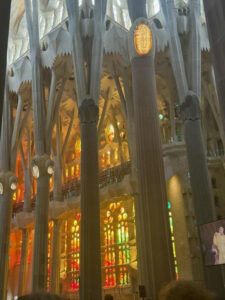 The American government has been transformed by Elon Musk’s Department of Government Efficiency. We’ll see how the new changes impact the way government works here on our side of the Atlantic… or doesn’t work.
The American government has been transformed by Elon Musk’s Department of Government Efficiency. We’ll see how the new changes impact the way government works here on our side of the Atlantic… or doesn’t work.
Further, the Sagrada Família – and, I’m guessing most of Barcelona’s ever-present art and architecture – was funded purely through private donations. The government doesn’t have to have a role in everything. In fact, in America, government ruins everything it touches, because of set-asides, over-regulation and artistic scrutiny of everything – except for “art” sanctioned by the leftists at the National Endowment for the Arts.
That’s right – a government agency decides what projects to fund. Would they choose a giant cathedral in the middle of a city as a worthy recipient for a financial boost? Doubtful.
Barcelona takes pride in its culture, religion and history, which makes it a welcoming place to vacation.
Much of the more recent United States-based artwork includes wall paintings of George Floyd and statues dedicated to disunifying progressive themes in addition to the renaming of old streets and buildings to reflect the more contemporary interpretation of their historic value. I’m frankly surprised that any monuments to the Confederacy still exist.
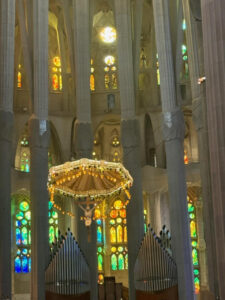 As a side note – President Trump announced many of the monuments that were taken down during Joe Biden’s tenure will be restored to their previous positions. Why try to erase history?
As a side note – President Trump announced many of the monuments that were taken down during Joe Biden’s tenure will be restored to their previous positions. Why try to erase history?
Trump’s work in formulating the planks of the MAGA agenda was impressive, but there are lessons to be learned from visiting cities such as Barcelona. Just because something is old and contains questionable aspects of history doesn’t make it invalid. Culture means things, too.

